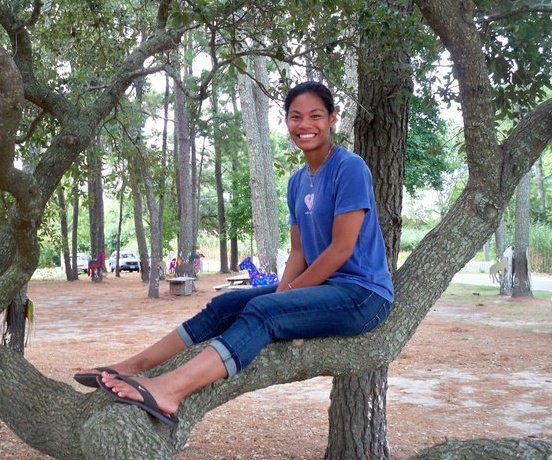The road to activism is filled with good food
By Tricia J. Capistrano
I got a scolding from Amy Besa.
The original draft of this article was about how she and Romy Dorotan, through their restaurants Cendrillon and Purple Yam, “elevated” Filipino food. “It has been my intent to fight against the concept that we need to elevate,” Amy wrote. “It is we who have to bring ourselves to the level of the food… learn more about our ingredients, cooking methods and traditions so that we can do justice to the food.”
In the mid-90s, when I moved from Manila to New York for grad school, there were three other Filipino restaurants. They were turo-turo style, the restaurants were small and dark, one couldn’t linger with a barkada.
When I discovered Cendrillon (named after a French ballet), all my senses told me immediately it was special, thus my use of the word “elevated.” The ceilings were 20 feet tall and adorned with 5 feet long bamboo and rice paper centipede lamps by Perry Mamaril. The kitchen was at the center of the restaurant. It was open and spotless, you could see Romy cooking. And then there was the food.
Peter Kaminsky, author of numerous books on cooking, wrote that the food was “clean tasting, the mark of a chef who could assemble a panoply of tastes without confusing them in a saucy jumble.”
Frank Bruni of the New York Times writes that the bibingka is “subtle, nuanced and a good example of Mr. Dorotan’s refusal…to pander to diners’ expectations.” Overall, he wrote, the food is “daring, different and a sure remedy for the malady, too widespread these days, of dining déjà vu.”
For this Filipino American writer who grew up in Manila, it was like being introduced to your cousin who grew up elsewhere. It was familiar but there was something that made it stand out. The fresh lumpiang ubod was similar to the lumpiang ubod I grew up with but the Napa cabbage, carrots, shredded string beans and jicamas were crunchier, and the wrapper was made of ube! The vegetables and shrimp in their ukoy were five times bigger and more fresh than what I was used to in Manila. For dessert, my favorite was a flat apple tart adorned with a beautifully swirled chocolate-like sauce. “Matamis na bao!” my friend exclaimed when we were met with the familiar taste. These non-traditional presentations of Filipino food sound ordinary now but in 1995 it was radical.
Interestingly, Amy and Romy’s path to Cendrillon and then their second restaurant Purple Yam are rooted in agitation. Amy and Romy met in Temple University in Philadelphia, while both were decamping from the Marcos government. Both were student activists at the University of the Philippines. Amy was on the Marcos arrest list and fled Manila. Romy’s brother was a cadre leader against the Marcos government and was killed. Amy and Romy were both distributing leaflets for the Kilusan ng mga Demokratikong Pilipino at Temple when they met. At that time, KDP’s purpose was to fight against Martial Law and the Marcos regime.
To make ends meet, Romy worked as a dishwasher at the Frog, a reputable high-end restaurant that served French – American – Thai food. When the chef at the Frog left and took the entire kitchen staff with him, Romy was promoted to chef. After her coursework, Amy taught Communications at Temple and then in the summers worked as a baker at the Commissary.
Amy has always loved cooking. Growing up, she spent her summers cooking and making preserves with her grandmother in Iba, Zambales. As for Romy, before working at the Frog, he had never worked in a kitchen. He grew up, however, with “fusion” cuisine. His father was Chinese and migrated to the Philippines. His mom was from Bicol. Romy grew up eating Chinese and Bicolano dishes.
Because there were more Filipinos in New York than in Pennsylvania, the KDP asked Amy and Romy to move to New York City. Romy continued to work as a chef in upscale restaurants in Manhattan and Amy worked with the KDP team who helped Filipino nurses in New York. In the 80s, Amy was part of a team that appealed to the Immigration and Naturalization Service to give Filipinos who failed the nurses’ exam a two-year deferred period so they could study and take the test again before they lost their legal status in the U.S. When the KDP disbanded, Amy then tried the corporate world and after 10 years, both in their mid-40s, Romy and Amy decided to open the doors to Cendrillon. They billed Cendrillon as a pan-Asian restaurant inspired by Filipino flavors.
Our wedding reception
My husband’s and my wedding reception was held in Cendrillon in 1999. It was the first wedding reception held at the restaurant. Because my husband has Swedish ancestry, we had Swedish meatballs for appetizer and Ostakaka, a Swedish custard, for dessert. On the Filipino side, we served our guests chicken adobo, pancit bihon, and rellenong trout–stuffed with mushrooms, ikana, and raisins–with its head on, a shock to our non-Filipino guests!

In 2009, because of the high cost of rent in Soho, Romy and Amy closed Cendrillon and opened Purple Yam in Ditmas Park, Brooklyn where they lived. Five years later, they also opened Purple Yam Malate in Amy’s childhood home. I remember locals in Manila telling me that they found the set menu costly. Amy says, “My goal there was not to make money but to work with passionate chefs, pay them fairly, chefs who will look at what’s in the environment, work with fishers and farmers, and make them realize that what they have is equal or superior to the ingredients that they import.” Purple Yam Malate closed for dining after the pandemic but they still sell their exceptional buko pie. The filling is made of buko in different stages of ripeness– malauhog (very soft), malakanin, lukadon (more firm).
Through Purple Yam Malate, Amy met and was also able to promote other Filipino food and beverage enterprises and help create a community. They served Kalsada coffee after every meal. Carmel Laurino, a Filipino American from Seattle and co-founder of Kalsada specialty coffee, says “It was through Romy and Amy that I got to learn more about other people doing really interesting, really progressive, also attuned to the needs of producers and farmers in the Philippines.”
Francis Ang, Chef of Abaca, one of the New York Times 25 Best Restaurants in San Francisco in 2023, shared that Amy and Romy really helped pave the path for other Filipino chefs. “When we reached out to Amy, she happened to be in the Philippines and invited my wife, Dian, and me to her house. Amy put us in contact with people we should meet. She helped us understand the different regions. Not only did she help us better understand Filipino food that day, she also helped introduce us to a bunch of different varieties of ingredients we’d never seen before, different bananas, different ice creams, etc. She really opened our eyes to what Filipino food could be.”
Amy, together with Barbara Kirshenblatt-Gimblett was also responsible for the tribute to Doreen Fernandez in Gastronomica magazine in 2003. The magazine reprinted Fernandez’s seminal essay “Culture Ingested, On the Indigenization of Philippine Food.”
I shared with Amy that I have downloaded on my phone two podcasts that feature her and Romy– the Splendid Table episode on “Filipino food” (aired on Sept 14, 2018) and the Long Distance podcast episode called “Cendrillon” (aired on November 5, 2019). In the Splendid Table podcast, Amy talks about her framework on Filipino food. “Food that was always ours” like adobo, sinigang, and kinilaw and “food that we borrowed and made our own” like the Chinese and Spanish dishes lumpiang shanghai, pancit canton, afritada, and embutido. My favorite part is when Amy says that adobo, sinigang, and kinilaw are eaten by the richest and the poorest in the country. In a bittersweet way, we are “united in sourness.” In my own home, after 25 years of marriage, sinigang has found a special place in my mid-Western husband’s heart.
And then we talked about how Cendrillon and Purple Yam’s promotion of Filipino ingredients and cooking methods as well their hosting of chefs from other little-known cuisines was a continuation of their activism. “And food is very critical in activism, because there are the farmers, the fishers,” Amy added.
I said to Amy that I saved the podcasts because the content is meaty, they tell us more about the origins of our ingredients and our methods of cooking. I love it, I said because “it’s more than just saying masarap.” Amy laughed and said, “I can do that because THE FOOD IS MASARAP and you honor the food but by going deeper, your brain is thriving on it, the tastes kick off all kinds of brain activity.”
I understand Amy’s objection about the use of the word “elevated.” It suggests that the food being elevated is substandard which I didn’t mean to imply. Perhaps a better term is that they put Philippine ingredients and ways of cooking in the spotlight? If you travel around the world now, 29 years after Cendrillon opened, and dine at Philippine restaurants, I think because of Amy and Romy, the floodlights to Filipino food and methods of cooking have been illuminated.













